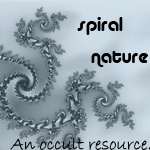100 Years of Fringe Religion: Thelema, Discordianism, Wicca, Satanism and…Atheism?
By Psyche | November 5, 2007 | Print This Post | E-mail This Post | 12 Comments
I was putting together a timeline for another essay when something occurred to me. Various religions that started as fringe have grown and expanded over the years, many becoming legitimate in the eyes of the mainstream (or at least, approaching legitimacy), but somewhere along the line we seem to have run out of steam.
Early into the twentieth century Aleister Crowley received Liber AL vel Legis or The Book of the Law, the central text of Thelema, a new religion or spiritual technology (I’ll leave it to those more invested to argue which description suits it best). Crowley joined the OTO and shortly afterwards assumed the role of the OHO, subsequently reworking its rites and rituals to integrate the principles of Thelema, effectively setting it up as a Thelemic organization, which it remains today.
In the late 1950s Malaclypse the Younger and Omar K. Ravenhurst received a divine revelation from a chimpanzee in a bowling alley. There they learned of Our Lady of Chaos, Eris. The Goddess of Discord was alive and well and continues to merrily wreak havoc on mortals, who don’t always seem to get the joke. Indeed, Kerry Thornley (Omar K. Ravenhurst) described it as a religion disguised as a joke disguised as a religion… Even so, Discordianism’s still around and stronger than ever, even if it’s not taken as seriously as some of its more greyfaced adherents would like.1
Gerald Gardner published Witchcraft Today in 1954 and in 1959, The Meaning of Witchcraft, fabricating a new religion in the process: Wicca. Literally hundreds of different traditions have sprung up in the wake of these two books. Wicca’s done a lot of growing up in the past fifty years, and it’s showing in a positive way. Today Wicca (and neo-Paganism in general) are far more accepted and understood than they were when the tenants of the general faith were still being invented.
Anton LaVey first published The Satanic Bible in 1969, and to my knowledge it’s remained in print ever since. The Church of Satan was founded in 1966, and many subsequent groups (The Temple of Set, the First Church of Satan) and traditions (Modern Satanism, Luciferianism, Setian, etc.) have sprung up since. Satanism’s always had a shady reputation, and continues to do so today, but the Satanic Panic of the 80s is over and it seems the mainstream is more broadminded than ever. Now Satanists can openly declare their religion in the British navy.
However, unless I’m missing something obvious (and that’s entirely possible), this brings us to the end of the list when it comes to religious innovation on the fringe: for the past thirty years we’ve been riffing of what we’ve already got. Sure, there’ve been many permutations of these (Wicca and Satanism especially), but after the 1970s we don’t see any new and markedly different fringe esoteric religions spring up.
A case might be made for chaos magick, which began in the late 1970s, but I consider it more of an approach to magickal practice than a spirituality in and of itself.
Likewise the 80s and 90s saw a rise in vampirism as a lifestyle and this arose a distinct subculture with esoteric overtones, but nothing constituting a distinct religion or organized spiritual system. Similar things can be said for the rise of Otherkin in the mid-90s, a time when aliens and UFOs were also the height of fashion.
I may be out of the loop, but the recent trend seems to be toward atheism (finally), and may become the characterizing feature of the ‘nills. It will be interesting to see where we go from here.
Footnotes:
- Yahoo! still lists Discordianism in its Humour section: http://dir.yahoo.com/Entertainment/Humor/Religion/Discordian/ despite loud protests and a petition to have it moved to the Religion category several years ago. [back]
Comments: (12) » | Trackback
Category: Essays & Opinion, Spirituality
Save & Share: Del.icio.us Digg Facebook Stumble it! Tweet





Don’t forget the Church of the Subgenius, TOPY, Burning Man, McKenna’s Timewavers…
I knew someone would bring up the Church of the Subgenius :) But I deliberately left it out as it’s more of a surrealist/postmodern movement than a spiritual organization – the same reason I left out the cults of the Invisible Pink Unicorn and the Flying Spaghetti Monster.
TOPY I lump in with chaos magick here, and again, there’s the lack of an organized spirituality. At least Discordianism has a disorganized spirituality, and after fifty years it’s got some street cred.
I can’t tell you how many times I’ve heard Larry Harvey state that it’s not a Pagan event – listen to the RU Sirius Radio Show podcast and take shots whenever he’s interviewed. That said – it’s effectively a festival, and not a religious movement in its own right. (I still maintain I’d like to go one year, I hear great things from folks I know online.)
McKenna’s Timewavers I’m not familiar with…! Googlemancy’s not turning up much. Enlighten me, please!
Timewavers was a word I made up for the purpose of describing those who subscribe to McKenna’s Timewave Zero theory (which is eminently Googlable).
Another point that should be made is that you shouldn’t only consider those innovations which can be “pinned down” with labels: for example, although we apply the same term to the acidheads of yesteryear and the acidheads of the present, their beliefs and paradigms tend to be very different. Sure, plenty of them are still spouting Leary quotes, but many have also incorporated Jungian and transpersonal psychology, modern physics, ethnobotany, Mayan eschatology and certain aspects of transhumanism and singularity theory in a way that would have been inconceivable in the ’60s. Fringe religion is changing, it just isn’t always changing its name.
Reading a little more about the Timewave Zero theory, it doesn’t strike me as particularly religious, or even overtly spiritual?
This post was looking exclusively at organized religions, but perhaps you’re suggesting that the trend in the past thirty odd years has been to move away from that model to something more fluid? There’s definitely something to that.
Spiritual technologies still abound and innovations are still being made, but I think you’re right, they’re not being codified in the same way they once were. What effects do you see resulting from this?
Ah, I missed the part where you were talking about organized religion specifically – in which case you’re right, there hasn’t been a whole lot of innovation lately (though if Discordianism can be called an organized religion, I still think the Church of the Subgenius should also qualify). It’s possible that organized religion is dead – killed by an increasing awareness of its limitations, and a return to personal religion founded on individual experience (the only kind of religion William James acknowledged as ‘true’ religion). Sure, you’ve got your Neopagans and your Thelemites and so forth, but they don’t have the fresh spirit they once had.
As for effects – I have an intuition that the whole morass of modern fringe spirituality is moving, consciously or unconsciously, toward the creation of a kind of Grand Unified Myth or GUM. I mean “myth” here in the Jungian or Campbellian sense of a totalistic worldview, an all-encompassing paradigm which is guiding personally meaningful. They’re grabbing wisdom and knowledge from all kinds of obscure sources and cooking it all together lightning-quick (we could call this the act of chewing GUM), synthesizing something that actually kind of works in the modern day. And since modern man is kind of missing a soul, this is vital.
i am writing the book on GUM as we speak, it will be out before 2012. the fringe traditions have indeed been moving in this direction.
as above so below, all is one. AUM-GUM
bfore the beginning was only the infinate primordial see of ether-prima materia/space/collective unconscious/zero/great goddess/varda/tao/tiamat/nuit/chaos/nyx/Mammu/Danu/nameless.
from her womb came into being the self-created assemblage point of awareness/Great Spirit Eagle-all father/Self/seed/zero-point field/yahweh/manwe/hadit/one/ahura mazda/osiris/atum/an-enlil/dagda/odin/jupiter/quetzalcoatl/air.
and in the tention created by this new found dual exitence and the copulation of the two a Giant Dragon god-serpent/shadow-trickster/entropic wave form/time-old man/change/power/knowledge/satan/morgoth/enki/coyote/ariman/saturn/Geb-set/crom/tezcatlipoca/utgard-loki-mimir/erebus was born.
the seed sprouted and within it’s shell a great Tree/physical world/gaia living universe/Earth-Mother/Goddess/the world/yvanna/world tree of life-knowledge/yggdrasil/turtle mountain/coatl/pachamama/maat/ninhursag-Ki/ grew and grew and grew…
and tere are four others that form the universal pantheon, the expression of the basic archetypes of all knowledge pre-existent within the collective unconscious and expressed as the basis of all religions/modes of thinking/paradigms.
tree-body mater etc. all these are reflections of the basic archetypes of the collective unconscious which are in turn reflections of the basic ANIMATE proccess which compose local reality, the explicit order, which in turn reflect the non-local implicit order. of the four other basic archetypes can you guess what they are? given this pan-theology, did doesn’t matter which religion (materialism is a religion too, sorry guys) you choose as they all reflect an underlying GUM that is innescapable, even discordianism/taoism fits in.
there is an omega point of knowledge, just look for your self. the fringe religions are mearly the realization of those archetypes/dieties/enbodied precesses that had previously been supressed by the lopsided christian, and in turn materialist paradigms
The Church of the Subgenius doesn’t really have any spiritual tenants. Discordianism might be silly, but at least they’ve got a disorganized theology.
Fresh spirit or not, Thelema is still kicking, and neo-Paganism’s bigger than ever – even approaching mainstream.
As for chewing on GUM, I get the sense of a greater understanding that people approach things from their own perspective. I see a growing acceptance of this on a day-to-day basis than I did in the past, and it’s causing me to reevaluate my actions and reactions to better integrate myself with this new way of being.
We live in interesting times.
Many hate it. A lot of people despise it! Personally, Im not so much a fan of its organized variance.
That being said, Scientology is a spiritual framework, and no more or less silly in its specific beliefs than any other religion, and considering the play its been getting lately, and how.. well.. accepted it is..
Surely it counts, right?
I admit, I’m only vaguely familiar with Scientology. I understand that Hubbard was friends with Jack Parsons (prior to dating his girlfriend, stealing his money, and buggering off) and I know there’s an occult connection there, but I don’t know enough about Scientology to know how much of that sort of thing carried over, or much about its religious tenants.
Though I see it was begun in 1952, making it roughly the same age as Wicca and Discordianism. Where’s that creative spirit now?
[...] November, among other things, we looked at 100 years of fringe religion, chaos magick, secrecy and experimented with a series of posts on themed collections of books [...]